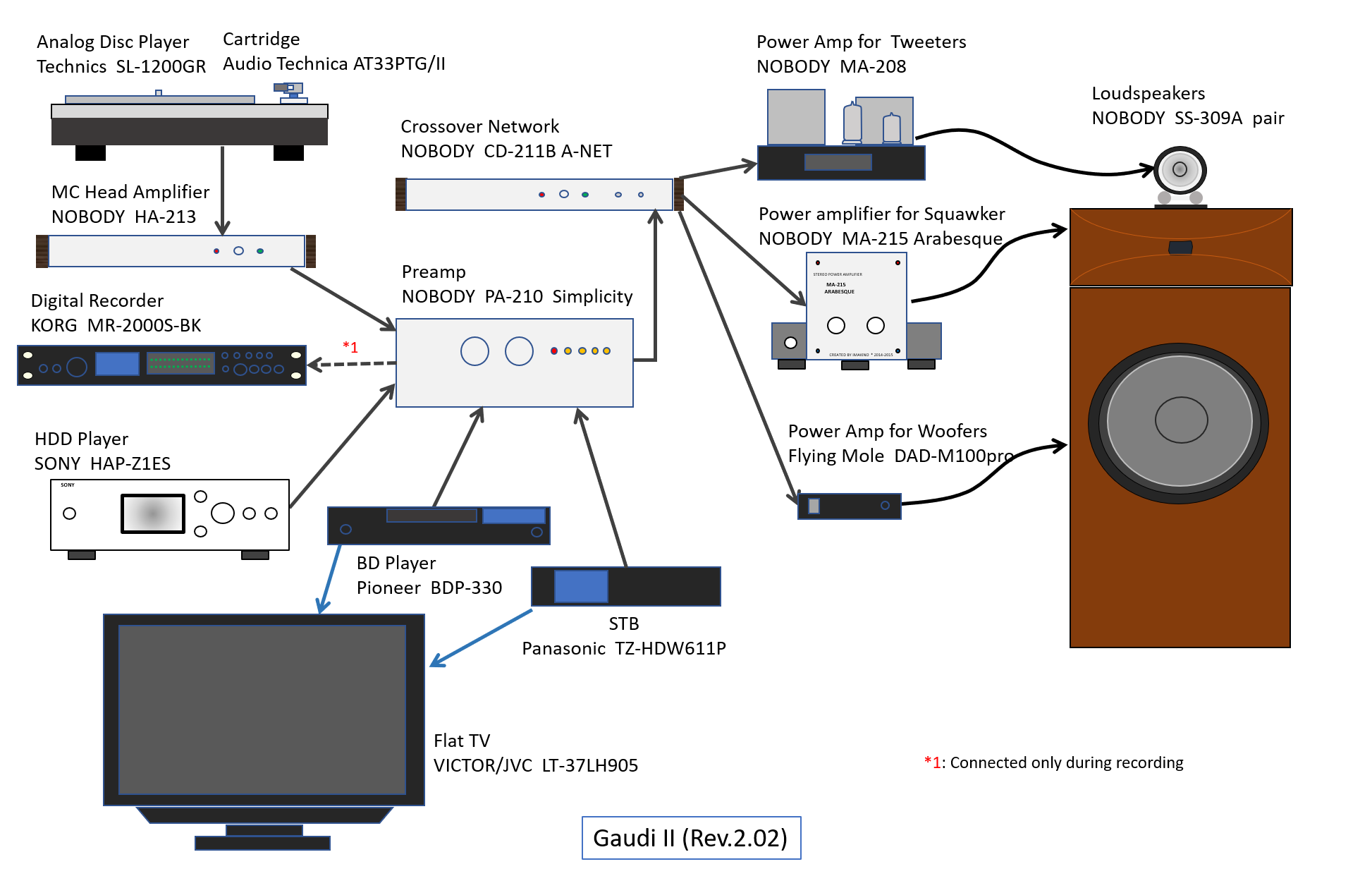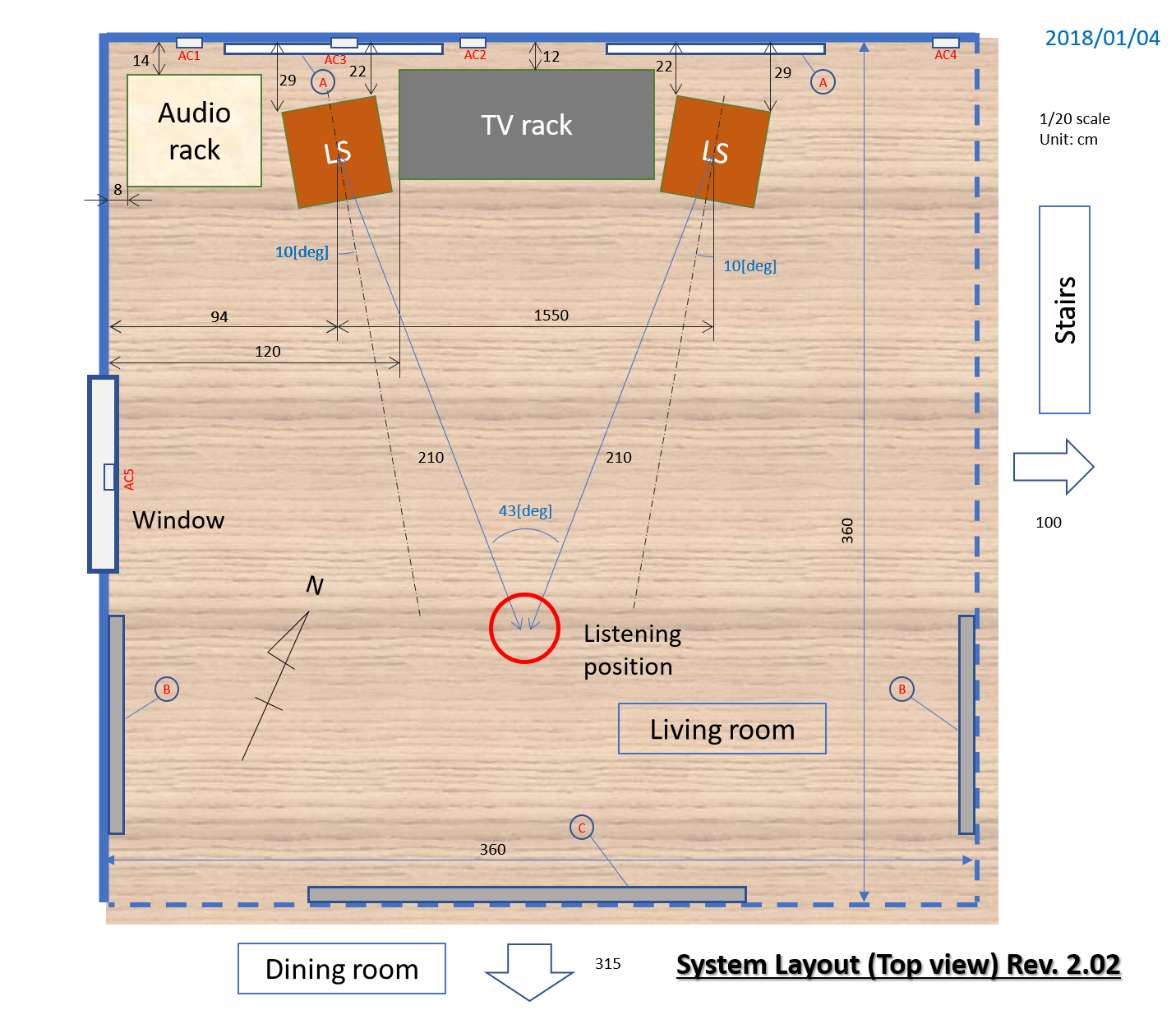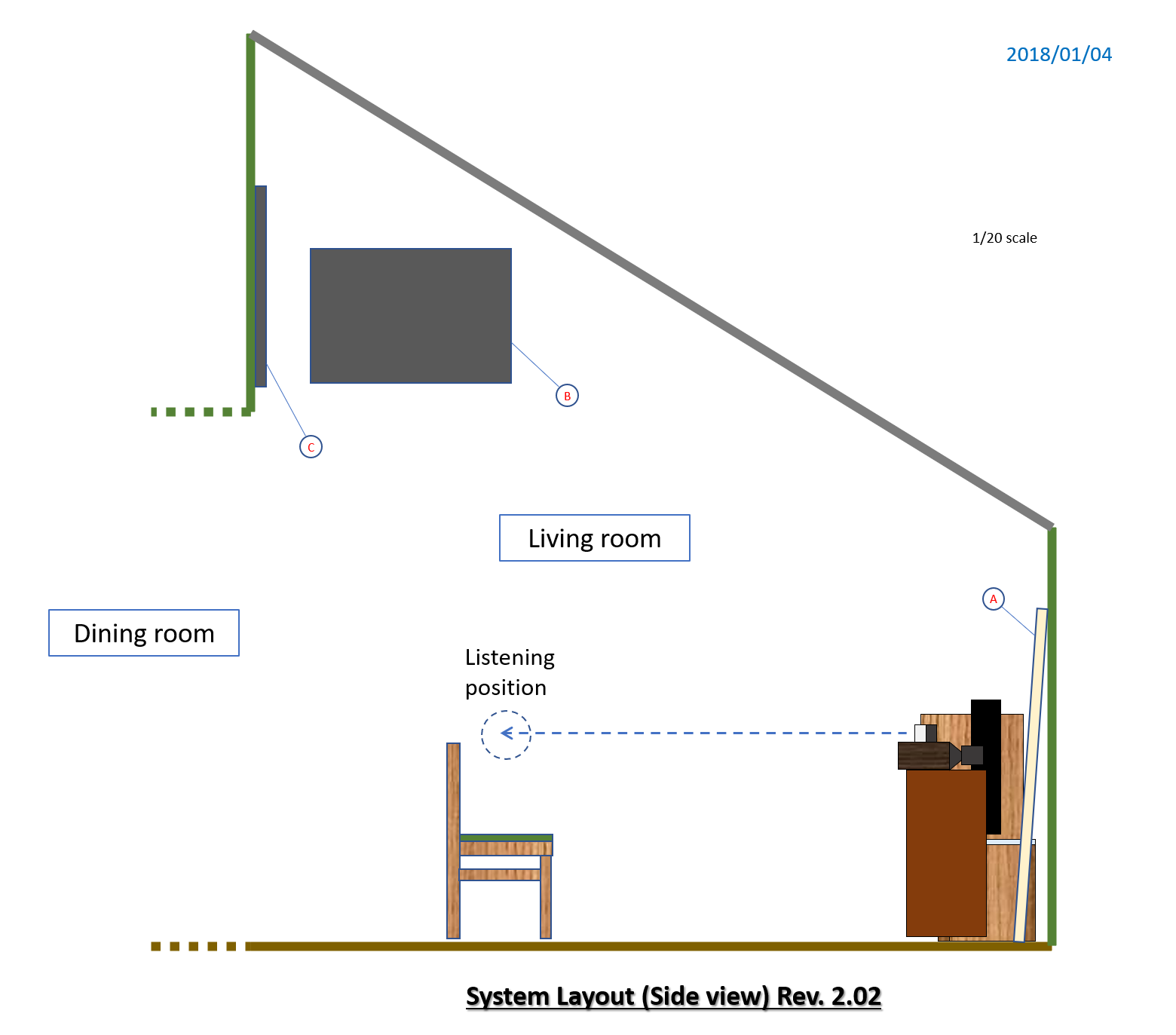Gaudi Rev.2.02
2018/12/29 created
2022/10/24 updated
The woofer amp was changed from the self-made tube amp MA-201C to the Flying Mole DAD-M100pro (two units). (September, 2017)
Configuration

I finally repleced MA-201C, which was the first component I built for Gaudi
and the first NOBODY-branded component.
It has been working in Gaudi for 43 years since 1974. Though some improvements
were made on it, the half of the parts remain unchanged. With the exception
of troubles caused by life-expired vacuum tubes and high-voltage electrolytic
capacitors, no failure has occurred.
Since I decided not to use any tube amplifier in the system design of Gaudi
II, I replaced MA-201C with Flying Mole DAD-M100pro, which is a semiconductor
amplifier.
DAD-M100pro was used previously as a squawker amplifier, so it is not a
new purchase. It has been stored in a closet for the last few years. It
seems to be good for the woofer amp, so I decided to use it again.
For details of this amplifier, please refer to the page "Commercial Products".
There are no changes to the other components from the previous revision (Rev.2.01).
Layout

The component layout is as shown on the right (click to zoom up).
Since the lowest tier of the audio rack AR-416 Air where MA-201C had been placed was empty, I placed acoustic measurement instruments there. Now the instruments are at hand, and I can make acoustic measurements anytime I want. This is helpful for gathering and saving acoustic data.
The following two figures show the layout of the whole system.
Since the acoustic design hasn't been made yet, this is a tentative plan.


The panels designated by A, B, and C in the figure are sound absorbing panels. The details are explained in the section "Room Acoustics".
Cabling
The cables used in Gaudi II are as shown in the table below.
The woofer cables were 3.6m long in the past. That length was necessary,
because the woofer amp MA-201C,which was placed on the audio rack AR-416 Air, was far from the right channel woofer.
By changing the woofer amp to a small mono amp DAD-M100pro, it has become
possible to place it near the woofer. Consequently, the length of the woofer
cable can be halved. It's 1.8m now.
| From | To | Wire | Length | Sender connector | Receiver connector | Note |
|---|---|---|---|---|---|---|
| ADP (SL-1200GR) |
MC head amp (HA-213) |
Low capacitance unbalanced wire (1-core shielded) |
1.5m | RCA plug | RCA plug | SL-1200GR's accessary Tied with earth wire Stereo pair |
| MC head amp (HA-213) |
Preamp (PA-210) |
OFC balanced wire (2-core shielded) BELDEN 8412 |
1.5m | Teflon insulated RCA plug Cold-GND connected |
Teflon insulated RCA plug | Unbalanced Stereo pair |
| DAP (HAP-Z1ES) |
Preamp (PA-210) |
OFC balanced wire (2-core shielded) BELDEN 8412 |
1.5m | RCA plug Canare F-10 Cold-GND connected |
RCA plug Canare F-10 |
Unbalanced Stereo pair |
| BDP (BDP-330) |
Preamp (PA-210) |
OFC balanced wire (2-core shielded) BELDEN 8412 |
3m | Teflon insulated RCA plug | Teflon insulated RCA plug Cold-GND connected |
Unbalanced Stereo pair |
| STB | Preamp (PA-210) |
OFC balanced wire (2-core shielded) NEGLEX 2549 |
3m | RCA plug Neutrik NYS373-0 |
RCA plug Neutrik NYS373-0 Cold-GND connected |
Unbalanced Stereo pair |
| Preamp(PA-210) | Network (CD-211B) |
OFC balanced wire (2-core shielded) BELDEN 8412 |
1m | Teflon insulated RCA plug Cold-GND connected |
はんだ付け Cold-GND connected |
Unbalanced Stereo pair |
| Network (CD-211B) |
Tweeter amp (MA-208) |
OFC balanced wire (2-core shielded) BELDEN 8412 |
3m | Soldered Cold-GND connected |
Teflon insulated RCA plug | Unbalanced Stereo pair |
| Network (CD-211B) |
Squawker amp (MA-215) |
OFC balanced wire (2-core shielded) NEGLEX 2549 |
3m | Soldered | RCA plug Neutrik NYS373-0 Cold-GND connected |
Unbalanced Stereo pair |
| Network (CD-211B) |
Woofer Amp (DAD-M100pro) |
OFC balanced wire (2-core shielded) NEGLEX 2549 |
3m | Soldered Cold-GND connected |
RCA plug Neutrik NYS373-0 |
Unbalanced Mono x2 |
| Tweeter amp (MA-208) |
Tweeter (T925A) |
OFC speaker cable Audio Technica AT365S |
2.8m | Soldered | w/o plug Titan oil applied |
|
| Squawker amp (MA-215) |
Squawker (D1405+H400) |
OFC speaker cable Audio Technica AT365S |
2.8m | Soldered | w/o plug Titan oil applied |
|
| Woofer Amp (DAD-M100pro) |
Woofer (FW305) |
0.65mm ETP copper single wire 47 Lab Stratos |
1.8m (Amp to woofer terminal) |
w/o plug Titan oil applied |
Soldered | Two wires twisted at 30cm pitch |
For some of the unbalanced wires, the shield is connected to the ground
at the sender end, and for the others, at the receiver end.
This ununiformity was caused by my changing belief. I used to believe the
sheild should be connected to the ground at the sender end. Now I believe
the receiver end is better. I'm planning to replace all the line cables
after a new preamplifer (PA-217, maybe) is completed.
AC Power Supply

The figure on the right shows the AC power connection (click to zoom up).
The 200V outlet is not used currently. The 200V power supply should be dropped to 100V with the step-down transformer, but this transformer is a bit hard to use. When the load is heavy, it produces a beeping noise. If the load is light, the secondary voltage will be high. I'd like to use it for a high output power amplifier, but the regulation may degrade due to the internal impedance of the transformer. If the bigger transformer is used, the beeping noise may be louder.
In the system design of Gaudi II, the transformer is supposed not to be used. The future preamplifier (PA-217) is equipped with an AC/DC converter with wide input voltage range (85-264V). It will be directly plugged to the 200V outlet.
Room Acoustics
I continued to use the acoustic goods I had employed for Gaudi.
For details, please see the page "Problems in Gaudi".
The sound absorbing panels and the acoustic panels designated by A to C in the overall layout diagram shown in the "Layout" section are effective to improve the room acoustics. The effects of other measures are not clear.
| Ref. | Material | Size | Location | Effects |
|---|---|---|---|---|
| A | 18mm thick MDF board Sound absorbing panel for ceiling (Solaton Cube 12 SC12-26T) |
910 x 1230mm | Leaned against the wall behind the loudspeakers (SS-309A) |
Reinforced bass |
| B | Tokyo Bohon SoundGurard W 50 | 910 x 600mm | High position of the left and right walls (2 places) |
Somewhat effective in suppressing excessive reverberation |
| C | Tokyo Bohon SoundGurard W 50 | 1820 x 910mm | Half wall opposite to the loudspeaker side | Focused sound image Stable localization |
I still feel excessive reverberation. Additonal sound absorbing panels
are necessary.
The materials of the walls and the floor are too thin and easy to resonate.
I replaced the carpet with "Tile Carpet". Then the resonate of
the floor has stopped.
Until then, the floor vibrated so much I could feel the vibration with
my finger when I touched the floor, or even the table top. After the replacement
of the carpets, I don't feel vibration. The reasonably priced Tile Carpet
seems to have resolved one serious problem.
A piece of Tile Carpet is 40cm x 40cm in size, and weighs 0.9kg (rather
heavy). It was priced 300 yen at a nearby discount shop. Its base is made
of rubber-like material. It can absorb vibration.
First, I put 12 pieces on the floor. Then I added 4 pieces to cover the
floor near the loudspeakers (total 16 pieces).
I think the walls needs reinforcement.
My Review
Replacement of the woofer amps has imporved the sound quality of the bass.
The previous woofer amp (MA-201C) was a tube amp, and its DF (Damping Factor)
was low. The deep bass was OK, but mid- to high-bass sounds were not enough
in response.
The f0 (f zero: the lowest resonance frequency) of the woofer (Fostex FW 305)
is 25Hz, and the bass reflex port resonance frequency of SS-309A is 26Hz.
Around these frequencies , a large amplitude can be obtained by the resonance
phenomenon, so sufficient sound pressure will be obtained without supplying
a large current from the amplifier. The voice coil impedance of the woofer
increases in the band above it (50-70Hz), so supplying large current is
not necessary, either.
On the other hand, in the band of 70 to 150Hz, the high driving ability
of the amplifier is necessary. That is, a high DF amplifier is required.
The DF of MA-201C was insufficient.
By changing the woofer amp to the semiconductor amplifier DAD-M100pro and
cutting the woofer cables to half the length 1.8m, mid- and high-bass sounds
have been a bit enhanced. Even though the bass sounds have been enhanced,
the sounds of bass instruments are not unnaturally emphasized, but it became
more natural.
Even in the performance of big band jazz, the individuality of the bassist
has become able to be distinguished.
Sonny Clark 's "Cool Strutin" (LP, Sonny Clark, Cool Struttin', Blue Note/Music Matters, BST 81588), which is synonymous with modern jazz, was not my favorite performance, but the impression has been changed. The bass solo in the latter half of the song sounds really vivid and I can't help feeling listening pleasure. It is my favorite record now.
I had some of my friends check it out. They said, "the sound of the
bass is really real".
What Gaudi was the best fit for was reporduction of sounds of brass instruments,
the next was percussion instruments. Now the sound of bass has been added.
In the future, I'd like Gaudi II to be good at every musical instrument.
The harshest critic to me is my wife. Generally, women are not interested
in the prices and brand values of audio equipment at all. They have no
interest in mechanics or circuits at all, either. In addition, no matter
how hard their husbands work for their audio system, they never praise
their husbands' efforts. Besides, their hearing ability is higher than
that of men, they won't be satisfied with an audio system with only slight
distortion. I got a bitter comment from my wife over and over. She complined
more than one time, "why did you put such a junk (Gaudi) in the living
room?"
That wife finally praised me for my audio system's high sound quality.
She praised by saying "natural sound".
My wife is not interested in audio, but I sometimes take her to concerts,
so she knows the sounds of musical instruments. The expression "natural
sound" means Gaudi II sound is so close to the live sounds of instruments.
It seems that she finally liked Gaudi II (no longer a junk!).
I wanted to demonstrate the difference in characteristics between Gaudi
Rev.2.01 and Rev.2.02 with measurements. But I was unable to get data that
could be evidence to the improvement, because I am not skilled enough in
measurement. This is a problem to be solved in the future.